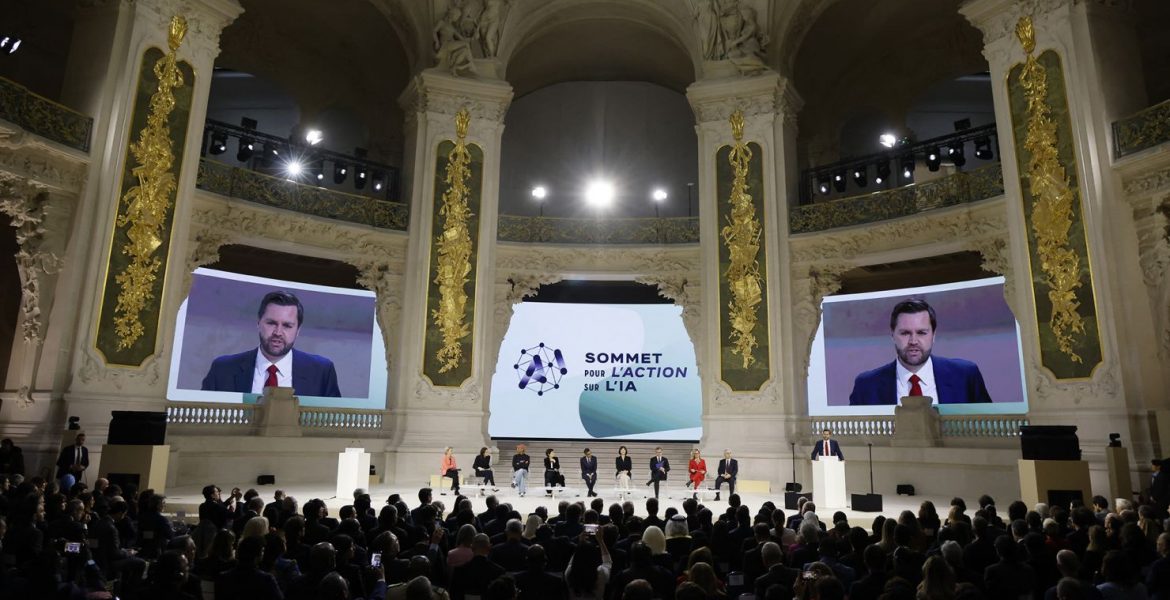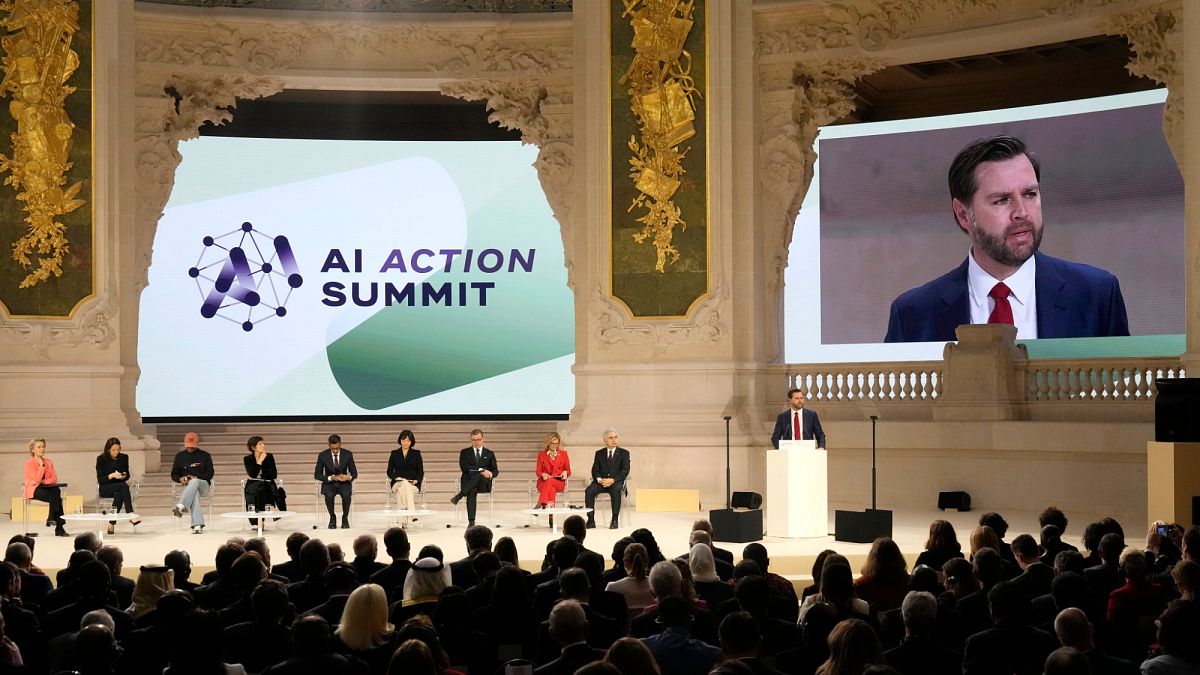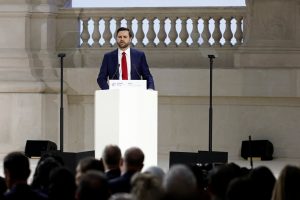
In his inaugural international address as Vice President, JD Vance delivered a masterclass in algorithmic governance and strategic foresight at the Paris AI Action Summit. His speech not only heralded his arrival on the global stage but also established a transformative policy blueprint designed to foster disruptive innovation while safeguarding the America’s competitive edge in artificial intelligence.
The US Vice President JD Vance articulated the Trump administration’s vision for artificial intelligence (AI), emphasizing innovation and cautioning against overregulation. He stated, “I’m not here this morning to talk about AI safety… I’m here to talk about AI opportunity. His speech, marries a visionary call for disruptive innovation with a robust defense of American industrial and technological leadership.
A Defining Moment in Diplomatic and Technological Leadership
In a setting where world leaders and tech titans converge to discuss the future of AI, Vice President Vance’s remarks resonated with both visionary zeal and meticulous pragmatism. He declared,
“Excessive regulation of the AI sector could kill a transformative industry just as it’s taking off.”
This potent message encapsulates his central thesis: while the promise of AI is boundless, its full potential can only be unlocked through a regulatory framework that empowers innovation rather than stifles it.
In his speech he called for a recalibrated approach to AI governance—one that contrasts sharply with the risk-averse frameworks favored by European counterparts. He further urged,
“We need our European friends to look to this new frontier with optimism rather than trepidation.”
This invitation is both a critique of overcautious regulation and a clarion call for international partners to embrace an innovation-first mindset.
Core Pillars of The Address
1. Disruptive Innovation and Regulatory Scaffolding
Vance’s address repeatedly highlighted that innovation must not be impeded by undue regulatory burdens. He warned that overly prescriptive measures could derail the transformative trajectory of AI technologies. His emphasis on deregulation is intended to foster an environment where cutting-edge developments can flourish—setting the U.S. apart as the leader in disruptive innovation.
2. Domestic Resilience Through Industrial Sovereignty
A standout segment of the video saw Vance stressing the strategic importance of bolstering America’s industrial base, particularly in the realm of AI chip manufacturing. He asserted,
“The Trump administration will ensure that the most powerful AI systems are built in the U.S. with American-designed and manufactured chips.”
This statement underscores a deliberate policy pivot aimed at reducing reliance on global supply chains and safeguarding national security, thereby ensuring that technological leadership is firmly anchored on domestic soil.
3. International Collaboration with a Strategic Edge
 While his speech was imbued with a strong nationalistic tone, Vance also underscored the importance of a collaborative international approach—provided it does not come at the expense of innovation. His call for European allies to adopt a more optimistic stance is an invitation for deeper transatlantic cooperation under a framework that emphasizes both open markets and strategic deregulation. The message is clear: an overly cautious regulatory environment may not only cede competitive ground to authoritarian regimes but also stifle the innovation needed to drive global progress.
While his speech was imbued with a strong nationalistic tone, Vance also underscored the importance of a collaborative international approach—provided it does not come at the expense of innovation. His call for European allies to adopt a more optimistic stance is an invitation for deeper transatlantic cooperation under a framework that emphasizes both open markets and strategic deregulation. The message is clear: an overly cautious regulatory environment may not only cede competitive ground to authoritarian regimes but also stifle the innovation needed to drive global progress.
4. Balancing Innovation with Ethical Oversight
Even as he pushes for deregulation, Vance recognizes the necessity of maintaining robust ethical standards. His vision entails a regulatory scaffolding that supports rapid technological advancement while ensuring that AI developments remain aligned with democratic values and civil liberties.
Enhanced Context: Global Policy Divergence
Vance’s remarks are set against a backdrop of divergent global policy frameworks. In Europe, measures such as the EU AI Act represent a comprehensive attempt to embed ethical safeguards and transparency into AI development. However, Vance’s vision challenges this paradigm by arguing that such precautionary principles may inadvertently hamper the dynamism of a transformative industry.
By championing a lighter-touch regulatory regime and emphasizing domestic resilience in chip manufacturing, his address positions the United States to maintain—and indeed, extend—its leadership in the global AI race. This strategic emphasis resonates deeply with the current geopolitical landscape, where technological hegemony is increasingly viewed as synonymous with national power.
Core Points Underpinning His Vision
At its heart, Vance’s address was built upon several foundational pillars:
a. Responsible Innovation
At its heart, Vance’s address was built upon several foundational pillars:
Vance’s central message was unambiguous: technological advancement must be pursued in tandem with a steadfast commitment to societal well-being. He warned,
“Excessive regulation of the AI sector could kill a transformative industry just as it’s taking off.”
This statement encapsulates his call for innovation that is both aggressive and ethically grounded. By integrating ethics into every stage of the innovation process, Vance emphasized that progress must be human-centered. He argued that while deregulation is essential to fuel breakthrough technologies, it must not come at the expense of safeguarding against algorithmic bias, data misuse, or other societal risks. His vision insists that the future of AI depends on a regulatory environment that empowers innovators without neglecting the public interest.
b. Multi-Stakeholder Governance
Vance’s vision for the future of AI governance is inherently collaborative. He called for a multi-stakeholder model that unites governments, tech firms, academia, and civil society, thereby ensuring that policy is shaped through comprehensive, collective insight. In his address, he urged,
“We need our European friends to look to this new frontier with optimism rather than trepidation.”
This statement not only challenges overly cautious regulatory frameworks but also underscores the importance of international dialogue. Vance’s approach posits that a balanced, inclusive governance structure is critical for creating adaptive regulatory scaffolding—one that can evolve alongside rapid technological progress and ensure that emerging AI systems serve the broader public interest while maintaining competitive dynamism.
c. Mitigating Technological Inequality
 With acute awareness of the risks posed by rapid digital transformation, Vance cautioned against a future where unchecked AI development could exacerbate existing socioeconomic disparities. He intimated that without intentional policy measures, the benefits of AI might be disproportionately concentrated, leaving vulnerable segments of society behind. Although he did not directly state a specific quote on this matter in the video, his overall rhetoric implies that inclusive innovation is imperative. His call to balance deregulation with ethical oversight is designed to ensure that technological advancements contribute to a more equitable society. This vision of mitigating technological inequality aligns with the broader goal of harnessing AI to not only drive economic growth but also to bridge the digital divide, ensuring that progress uplifts every layer of society.
With acute awareness of the risks posed by rapid digital transformation, Vance cautioned against a future where unchecked AI development could exacerbate existing socioeconomic disparities. He intimated that without intentional policy measures, the benefits of AI might be disproportionately concentrated, leaving vulnerable segments of society behind. Although he did not directly state a specific quote on this matter in the video, his overall rhetoric implies that inclusive innovation is imperative. His call to balance deregulation with ethical oversight is designed to ensure that technological advancements contribute to a more equitable society. This vision of mitigating technological inequality aligns with the broader goal of harnessing AI to not only drive economic growth but also to bridge the digital divide, ensuring that progress uplifts every layer of society.
Together, these pillars form the bedrock of Vance’s strategic vision—one that seeks to harmonize disruptive innovation with responsible, inclusive governance. By championing a model where progress is tempered by ethical rigor and multi-stakeholder engagement, Vance sets a transformative agenda for the future of AI.
Reception and Immediate Repercussions
Leading media outlets across the globe have painted a multifaceted picture of JD Vance’s foreign debut at the Paris AI Summit. While many applaud his bold, deregulation-focused stance as a necessary catalyst for innovation, others express concerns over potential societal risks and the erosion of robust ethical oversight.
Key Reactions
-
-
Tech Industry and Pro-Innovation Advocates
Outlets such as Reuters and The New York times highlighted that Vance’s rhetoric, emphasizing that “excessive regulation could kill a transformative industry,” resonated strongly with those who view rapid deregulation as essential for maintaining U.S. competitiveness in the AI race. His focus on bolstering domestic AI chip production was seen as a strategic move to secure American industrial sovereignty and counter global supply chain vulnerabilities. -
European and Policy Critics
European leaders and several policy experts, as reported by The Guardian and Ap News, criticized his remarks for dismissing the need for balanced regulation. They warned that an overly permissive approach might jeopardize ethical standards and widen socioeconomic inequalities. His call for European partners to embrace AI with “optimism rather than trepidation” was met with mixed reactions, with some accusing him of oversimplifying the complex interplay between innovation, regulation, and societal well-being. -
Immediate Market and Geopolitical Impacts
The speech’s emphasis on domestic production and deregulation contributed to an immediate boost in tech stock prices—most notably in semiconductor companies—underscoring the market’s favorable response to his vision. However, the decision by the U.S. and the U.K. not to sign the summit’s declaration on inclusive AI further intensified transatlantic debates, potentially straining international cooperation on future AI governance.
-
Conclusion
 America’s V.P. JD Vance’s foreign debut is more than a ceremonial foray onto the global stage—it is a meticulously crafted policy manifesto that redefines the U.S. approach to artificial intelligence. With his clarion calls for deregulation, enhanced industrial sovereignty, and international collaboration based on an innovation-first mindset, Vance has laid a robust foundation for the future of AI.
America’s V.P. JD Vance’s foreign debut is more than a ceremonial foray onto the global stage—it is a meticulously crafted policy manifesto that redefines the U.S. approach to artificial intelligence. With his clarion calls for deregulation, enhanced industrial sovereignty, and international collaboration based on an innovation-first mindset, Vance has laid a robust foundation for the future of AI.
As encapsulated in his stirring video address, his message is unequivocal: to harness the full potential of AI, the United States must balance aggressive innovation with a regulatory framework that is both nimble and principled. In doing so, America will not only secure its competitive edge but also set a new global standard for responsible, forward-thinking technological governance.
Global Data Intelligence – Eminence global PR
We lead communications through data-driven strategy and intelligence. With our unwavering focus on business outcomes and never-ending cycle of intelligence gathering, we ensure our clients’ sustained success. We provide an advantage to our clients, finding the truth – about their audiences, the operating environment and their competition, helping them realize their goals.
This entails;
- Reputation Intelligence
- Thought Leadership Strategies
- Outcomes Design & Evaluation,
- Audience Segmentation & Messaging Strategies,
- Trend & Issue Assessments and
- Behavior Change Intelligence
